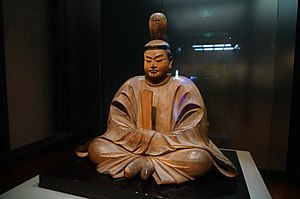Hachiman

Yahata, which was originally pronounced as "hachiman" in ancient Shinto, is a syncretic deity in Japanese religion. He is associated with archery and war,[1][2][3] and is a combination of both Shinto and Buddhist beliefs.[4]
Hachiman is a Shinto god who represents archery and war. He is also known as Yahata and is a syncretic divinity that incorporates elements from both Shinto and Buddhism. Hachiman is said to be Emperor Ōjin by birth, who reigned in the 3rd-4th century, and was later deified and identified as "Yahata-no-kami" which means "Kami of Eight Banners." He is also called Hondawake. The dove is his messenger, and he is associated with samurai banners and symbolizes both the bow and arrow.
Hachiman has been worshiped by farmers and fishermen since ancient times. Farmers believe he is the god of agriculture, while fishermen pray to him to fill their nets with plenty of fish.
During the samurai period, Hachiman was worshipped by the descendants of two samurai clans - Seiwa Genji and Kanmu Taira. This tradition spread throughout Japan, and samurai clans began to honor Hachiman as their sacred deity. Hachiman's roles also included determining a samurai's fate in battle, protecting martial arts, and proclaiming the victory of an army.
Hachiman is a Shinto god who is mainly worshipped as the tutelary deity of warriors, though he is sometimes referred to as the god of war.[4][5] Additionally, he is also considered to be a protective deity of Japan, the Japanese people, and the Imperial House
Related pages
[change | change source]- Bishamon -- Shinto-Buddhist God of War
References
[change | change source]- ↑ Kanda, Christine Guth. "Shinzō: Hachiman Imagery and Its Development".
{{cite journal}}: Cite journal requires|journal=(help). - ↑ Law, Jane Marie. "Violence, Ritual Reenactment, and Ideology: The "Hōjō-e" (Rite for Release of Sentient Beings) of the USA Hachiman Shrine in Japan".
{{cite journal}}: Cite journal requires|journal=(help) - ↑ "Hachiman & Hachimangū Shrines".
It was only later, sometime in the 9th century, that the deity became associated with Emperor Ōjin, and later still that Hachiman became worshipped as the god of archery and war, ultimately becoming the tutelary deity of the Minamoto clan and its famed warrior Minamoto Yoritomo 源頼朝 (1147–99), founder of the Kamakura shogunate
- ↑ 4.0 4.1 Scheid, Bernhard. "Hachiman Shreine" (in German). University of Vienna. Retrieved 17 August 2010. Cite error: Invalid
<ref>tag; name "scheid" defined multiple times with different content - ↑ Motegi, Sadazumi. "Shamei Bunpu (Shrine Names and Distributions)" (in Japanese). Encyclopedia of Shinto. Retrieved 23 March 2010.
Other websites
[change | change source] Media related to Hachiman at Wikimedia Commons
Media related to Hachiman at Wikimedia Commons
